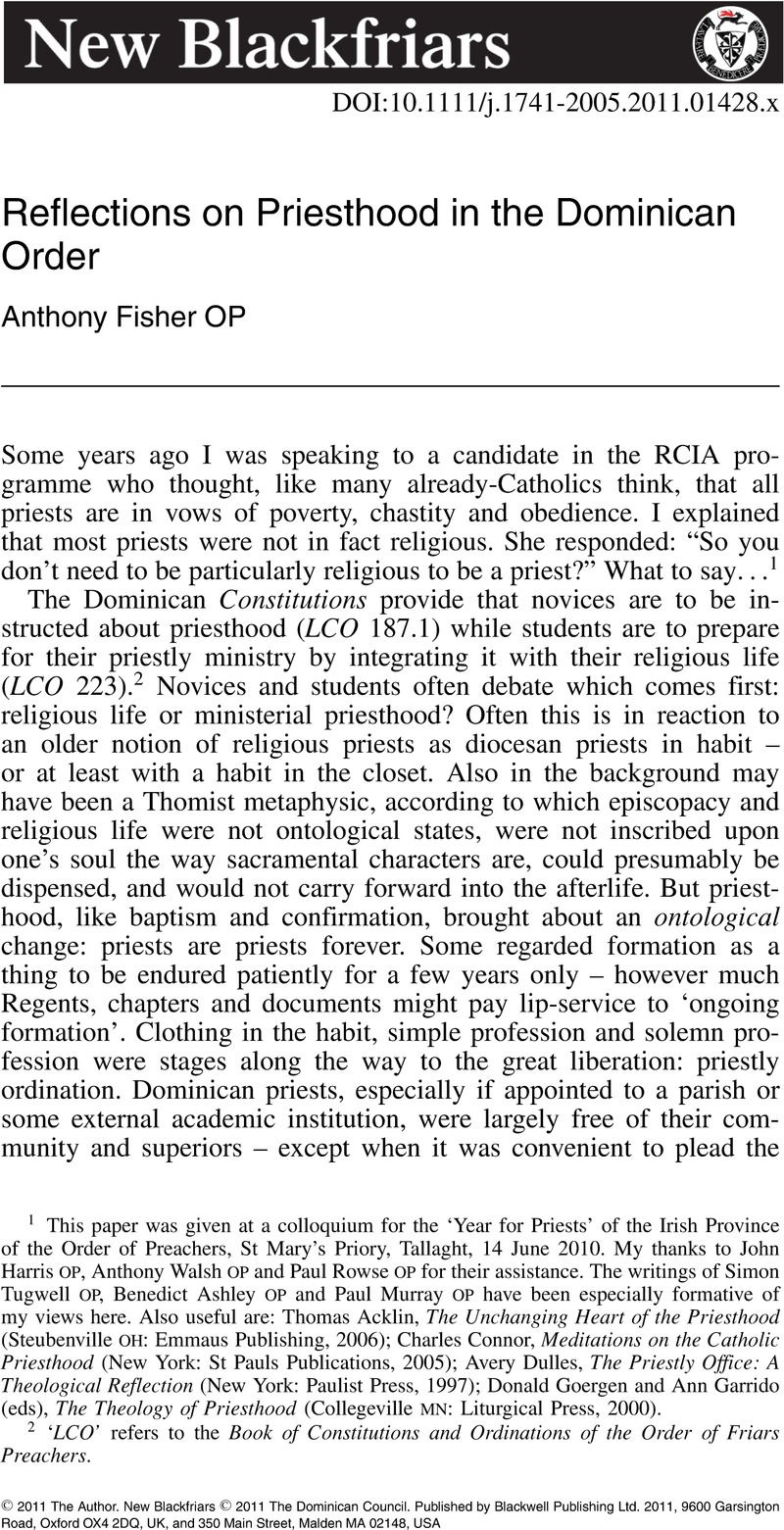Published online by Cambridge University Press: 01 January 2024

1 This paper was given at a colloquium for the ‘Year for Priests’ of the Irish Province of the Order of Preachers, St Mary's Priory, Tallaght, 14 June 2010. My thanks to John Harris op, Anthony Walsh op and Paul Rowse op for their assistance. The writings of Simon Tugwell op, Benedict Ashley op and Paul Murray op have been especially formative of my views here. Also useful are: Acklin, Thomas, The Unchanging Heart of the Priesthood (Steubenville oh: Emmaus Publishing, 2006)Google Scholar; Connor, Charles, Meditations on the Catholic Priesthood (New York: St Pauls Publications, 2005)Google Scholar; Dulles, Avery, The Priestly Office: A Theological Reflection (New York: Paulist Press, 1997)Google Scholar; Goergen, Donald and Garrido, Ann (eds), The Theology of Priesthood (Collegeville mn: Liturgical Press, 2000)Google Scholar.
2 ‘LCO’ refers to the Book of Constitutions and Ordinations of the Order of Friars Preachers.
3 Vatican Council II, Lumen Gentium: Dogmatic Constitution on the Church (1964) 10, after 1 Pet 2:9.
4 For examples of writers on the rivalry between ‘cultic’ and ‘prophetic’ models of priesthood, or between ‘cultic priesthood’ and ‘prophetic religious life’, see: Michael Buckley sj, “Jesuit Priesthood: Its meaning and commitments,” Studies in the Spirituality of Jesuits 8 (1976), 150–182 and Thomas Rausch sj, “What is Dominican priesthood?” Spirituality Today 42(4) (1990), 323–39.
5 On Dominic's inspiration and world see Guy Bedouelle op, Saint Dominic: The Grace of the Word (Trans. Noble, M. T., San Francisco: Ignatius Press, 1987)Google Scholar.
6 McPartlan, Paul, “Priesthood, priestliness and priests,” in Ronald Witherup et al, Ministerial Priesthood in the Third Millennium: Faithfulness of Christ, Faithfulness of Priests (Collegeville: Liturgical, 2009), ch 4.Google Scholar
7 Vatican Council II, Presbyterorum Ordinis: Decree on the Ministry and Life of Priests (1965). A recent study is Confoy, Maryanne, Religious Life and Priesthood: Perfectæ Caritatis, Optatam Totius, Presbyterorum Ordinis (New York: Paulist Press, 2008)Google Scholar.
8 Vatican Council II, Perfectæ caritatis: Decree on the Adaptation and Renewal of Religious Life (1965).
9 O’Malley, John, “Priesthood, ministry, and religious life: Some historical and historiographical considerations,” Theological Studies 49 (1988), pp. 223–257CrossRefGoogle Scholar pointed out that Presbyterorum Ordinis assumes that all priests are presiding over local communities of the faithful and exercising a primarily sacramental ministry, in hierarchical union with the bishops; the model chosen as paradigmatic of priesthood is that of the diocesan clergy. Thomas Rausch, a Jesuit, (art. cit.) suggested that Dominican priesthood can offer a different paradigm also rooted in the tradition but also, as I will suggest below, supported by Presbyterorum Ordinis.
10 St Thomas Aquinas, Summa theologiæ IIa IIæ, 184, 5.
11 H. C. Scheeben, Albert der Grosse. Zur Chronologie seines Lebens (Vechta, 1931), pp. 154ff. On the background tp this emotional letter and its retention and transmission, see Rudolf Schieffer, “Albertus Magnus: Mendicancy and theology in conflict with episcopacy,” (trans. Thomas O’Meara), http://www.nd.edu/~tomeara/schieffer.html#[64].
12 On the history of this dispute see Jean-Pierre Torrell op, Saint Thomas Aquinas, Vol. 1: The Person and his Work (Trans. R. Royal, Washington dc: CUA Press, 1996), ch 5. He follows especially Dufeil, M.-M., Guillaume de Saint-Amour et la polemique universitaire parisienne 1250–1259 (Paris, 1972)Google Scholar.
13 Simon Tugwell op in his Introduction to Early Dominicans (New York: Paulist, 1982), p. 14Google Scholar, relays a story told in the Order of Pope Innocent III wondering to himself why Dominic wanted to found an order consisting entirely of bishops. The pope was confused because it was still assumed that bishops were the only ordinary preachers.
14 Tugwell, Simon op, The Way of the Preacher (London: Darton, Longman & Todd, 1979), p. 13Google Scholar.
15 ‘Miscellaneous stories,’ in Tugwell, Early Dominicans, p. 139.
16 Torrell op, St Thomas Aquinas, follows especially Dufeil, M.-M., Guillaume de Saint-Amour et la polemique universitaire parisienne 1250–1259 (Paris, 1972)Google Scholar.
17 Bld Humbert of Romans op, Treatise on Formation of Preachers III, 21: “When Christ was in this world, he celebrated Mass only once, on Mandy Thursday. We do not read of him ever hearing confessions. He administered few sacraments and those infrequently. He did not often assist at any canonical divine worship… Once he started preaching… he devoted his whole life to preaching, even more than to prayer.” On and around this theme see Tugwell The Way of the Preacher, ch 3 and Murray, Paul op, “What is Dominican spirituality?” in The New Wine of Dominican Spirituality: A Drink Called Happiness (London: Burns & Oates, 2006), ch 1Google Scholar.
18 St Thomas Aquinas, Summa Contra Gentiles IV 74 & 75; Trent, Session XXIII, Decree on the Institution of the Priesthood of the New Law, ch I and Canons on the Sacrament of Order can I.
19 Presbyterorum Ordinis 1.
20 Presbyterorum Ordinis 2.
21 Presbyterorum Ordinis 4.
22 Connor, Meditations, ch 8.
23 Paul VI, Evangelii Nuntiandi: Apostolic Exhortation on Evangelization in the Modern World (1975) and John Paul II, in many places, e.g. Redemptoris Missio: Encyclical Letter on the Church's Missionary Mandate (1990) and Novo Millennio Ineunte: Apostolic Letter at the Close of the Great Jubilee (2000).
24 Benedict XVI, Verbum Domini: Post-Synodal Apostolic Exhortation on the Word of God in the Life and Mission of the Church (2010) 59–60, 78–83, 90–98.
25 I here leave aside the question of if and how the unbaptized can receive these benefits too.
26 Once again, secular priests such as Gustavo Guiterrez can become friars, so there are exceptions.
27 Vatican Council II, Lumen Gentium 10.
28 McPartlan, art.cit., p. 83.
29 Of many good treatments of the Eucharist and the Priesthood, I recommend Connor, Meditations, ch 6.
30 E.g. in Tugwell, The Way of the Preacher, ch 5.
31 Summa theologiæ IIaIIæ 86, 2; IIIa 22, 1; 63,6.
32 Monum. Ord. Præd. Historia, V, 53.
33 Summa theologiæ IIa IIæ, 182.